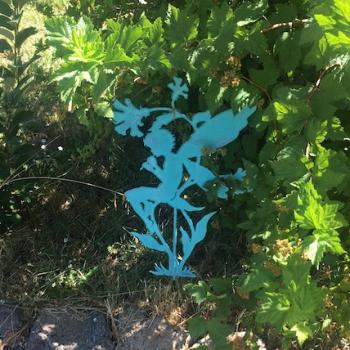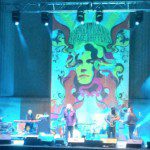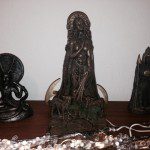Gateways to Paganism: Led Zeppelin

(Pagans don’t proselytize, and the majority of us don’t have Pagan parents; as a result, people come to Modern Paganism through various means. For many of us, books, movies, and music provided the impetus to walk the Pagan Path. Gateways to Paganism is one guy’s attempt to document some of the things that have led various people to Paganism, and why those things had that effect.)
Led Zeppelin was my gateway to Paganism. Sure, I can reflect in the present day and see all sorts of other “stairways to Pan,” but it’s really Led Zeppelin that’s brought me here. Led Zeppelin took me from being president of my church youth group to Witchcraft, and eventually to blogging for Patheos. Twenty years after first jumping on the Zeppelin bandwagon, that train keeps a rolling for me. I love a lot of bands, but I’m devoted to the Zeppelin. Now I certainly don’t expect everyone who grooves to Kashmir to suddenly start practicing Paganism, but in my case Zeppelin was certainly a formative influence.
Zeppelin as a pathway to Paganism is superficially obvious. Jimmy Page (guitar) and Robert Plant (vocals) both looked Pagan (or at least magickal) back in the 1970’s. Standing over six feet tall with perfect blonde ringlets for hair, Robert Plant towered over rock like an ancient Welsh Prince transported forward into 1973. Sure, he wore tie-dyed blouses and blue-jeans, but that simply showed how he was “one of us;” another average multi-millionaire hippy prowling the English countryside in search of whispered riddles and Celtic ghosts.
Jimmy Page was the other side of the coin. While Plant embraced the rustic hippy esthetic; Page was the high magus on stage, casting spells with his theremin and conjuring demon hordes by scraping a magic wand violin bow across his guitar strings. By the mid 70’s Page did all of that while dressing like the high wizard of rock and roll. Dragons crisscrossed his stage outfits, and he had “666” embroidered into the flare on his bell bottoms. Some of this sounds a bit silly today, but back in the day this was some serious mojo. Plant was the Cunningman of Albion; Page the London adept, perfect synergy indeed.
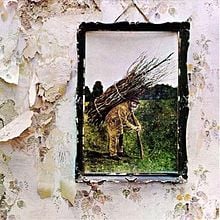
The cover of Led Zeppelin’s fourth album. Notice the lack of band name. Bloody awesome.
In a lot of ways Led Zeppelin’s fourth album (imaginatively titled Led Zeppelin IV, but probably better known as Runes or Zoso) sums up the Zep as pathway to Paganism experience. The cover of the album features a mysterious old man with a bundle of sticks on his back; an understated yet creepy image. According to the band, the picture represents humankind in balance with nature. Others have argued that the old man is meant to be English cunningman (and alleged teacher of Aleister Crowley) George Pickingill*.
The gatefold sleeve of the album features an obvious reference to the Hermit of the tarot. Page has been quoted on the record as saying “It actually comes from the tarot card of the Hermit,” so there’s nothing ambiguous about it. Even in my pre-Pagan days I recognized the Hermit from the Rider-Waite Tarot deck. I remember buying my first tarot deck in an attempt to understand Led Zeppelin a little better.
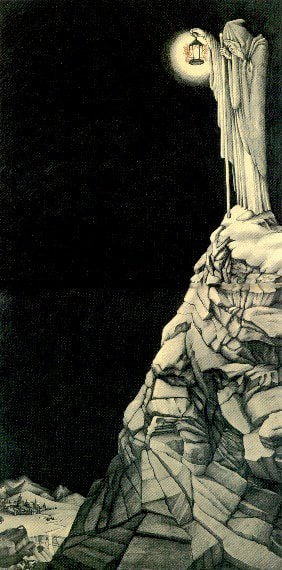
Just the Hermit from the tarot, nothing occult about any of this.
Outside of the music Led Zeppelin IV is probably best known for the mysterious runic symbols that originally graced the album sleeve (now the digital booklet that comes with a legal download). Runic symbols certainly don’t make someone Pagan or even magickal, but in the case of Led Zeppelin they certainly added to the mythic quality of the band. Two of the four symbols (those belonging to bassist John Paul Jones and drummer John Bonham) were taken from Rudolf Koch’s Book of Signs. Jones’ rune is said to represent competency and integrity (attributes that would have been appealing to the more serious Jones), while Bonham’s symbol looks similar to the one found on cans of Ballantine Beer (though it probably represents Bonham’s love of family).
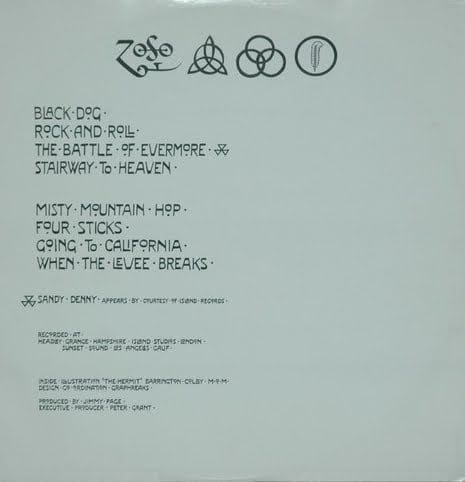
Album sleeve from Led Zeppelin IV. The symbols from left to right: Page, Jones, Bonham, and Plant.
Page and Plant personally created their runes for the album sleeve, which has led to a great deal of speculation over the years in Zeppelin fandom. According to the man himself, Plant’s feather in a circle “represents courage to many Red Indian tribes. I like people to lay down the truth. No bullshit, that’s what the feather in the circle is all about.”(1) Other have linked Plant’s symbol to Ma’at the Egyptian goddess of justice.
According to Page, his glyph (often dubbed “Zoso”) is about about “invoking and being invocative.”(2) The symbol itself bears a strong resemblance to a glyph found in the 16th century book Ars Magica Arteficii by J. Cardan. In a section on astrological signs the “Zoso” rune appears almost as it does in 1971. The separate components of the rune sign indicate different things. The stylized “Z” is a reference to the astrological sign of Capricorn, which is Page’s sun-sign. The “oso” is open to various interpretations; the two most common are that it stands for “666,” or that it represents the alchemical symbol Mercury.
Musically IV was just as adventurous as the runes, Hermit, and album cover. Containing straight ahead rock and roll (Rock’n’roll, Black Dog), references to Tolkien (Misty Mountain Hop, The Battle of Evermore), Joni Mitchell inspired folk (Going to California), heavy electric blues (When the Levee Breaks), and of course the impossible to classify Stairway to Heaven, Zep IV was an embrace of several moods and inspirations. As Pagan gateways, there are two songs which rise about the rest (though Levee is my favorite song on the album, probably, that might change tomorrow).
Stairway to Heaven is one of the most well known rock songs in history, and can still be anything anyone wants it to be. With its bustling hedgerows and shadows taller than our souls, it’s always felt “magical,” like there’s a hidden truth somewhere inside of it. The mysterious-sounding recorder at the song’s beginning creates an otherworldly atmosphere, and the gradual build of the song is transformative. The whole thing goes from Piper at the Gates of Dawn to Charge of the Light Brigade in eight minutes. The package was the perfect cocktail for my angsty teen soul hopped up on puberty, self-loathing, and confusion. Stairway didn’t open doors for me, it took a battering ram to them.
http://www.youtube.com/watch?v=9Q7Vr3yQYWQTo me “pagan music” is as much about atmosphere as it is about lyrics. The Battle of Evermore is a hodge-podge of Tolkien (“the ring-wraiths ride in black) and Christo-Celtic mythology (“I’m waiting for the angels of Avalon, waiting for the eastern glow”), but it feels like something that belongs at ritual or in the middle of a Pagan Festival. The sound of Page’s mandolin is like a time-machine transporting the listener back to the Dark Ages. There’s the male/female balance in the vocals of Plant and Sandy Denny (most famous for her involvement in Fairport Convention), and the opening pleas to the “Queen of Light” and the “Prince of Peace.” Lyrically, the song is a mess, but you can’t tell that while listening to it. It feels like a piece of Celtic Myth brought back from the dead; essentially it sounds pagan.
http://www.youtube.com/watch?v=mHJH0ETi8D4Stairway and Evermore aren’t anomalies in the Zeppelin cannon either. Kashmir, Over the Hills and Far Away, Ramble On, Gallow’s Pole, Immigrant Song, No Quarter . . . . . the Zeppelin catalog is full of songs with references to mythology, Tolkien, secret vistas, and hints of waiting to be discovered truths. Apart from the music and that stunning fourth album, Led Zeppelin offered a completely different pathway to Paganism-Jimmy Page.
While lots of bands in the seventies liked to reference the occult; Jimmy Page was actually a practicing occultist. He freely admitted in interviews to being an admirer of Aleister Crowley, though his actions showed someone who was far more than an “admirer.” Page was a collector of Crowleyana, building an extensive collection of Crowley artifacts including robes and various magical tools. Page even went so far as to buy Crowley’s old house (Boleskine House) on the shores of Loch Ness. Page would later go on to open up his own occult bookstore; The Equinox Bookstore and Publishers. (Sadly, Page would sell off both Boleskine House and Equinox in the 80’s.) It’s no wonder there’s Pagan-like stuff in Led Zeppelin, the occult was a daily part of Page’s life.
After reading this I think it’s rather obvious the many ways that Led Zeppelin can serve as a pathway to Paganism. In my case, Page’s obsession with Crowley introduced me to groups like the Golden Dawn and various other occult figures of the 19th and early 20th Century. Thanks to Robert Plant’s love of Celtic Myth I was led to pick up a bad Llewellyn book on Wicca entitled “Celtic Magic.” That book broke the levee and I began calling myself a Pagan three days later.
(Next time in Gateways to Paganism: Paul Huson’s “Mastering Witchcraft.”)
1. When Giants Walked the Earth: A Biography of Led Zeppelin by Mick Wall. St. Martin’s Press, 2008. pg 261
2. Wall. pg 262
(While there are many Zeppelin biographies in print, only Wall tackles the occult elements of the band head on. Wall seems to at least understand the occult, and avoids the laziness of claims like “Crowley was a Satanist.” Having read every Zeppelin biography under the sun, I was surprised at the depth in Wall’s book.)
*Pickingill was a 19th Century English Cunningman, and alleged Witch. According to some, Pickingill taught both Aleister Crowley and Gerald Gardner. While I seriously doubt he was a teacher of Gardner or Crowley, he was a real practitioner of magic. Page would have certainly been familiar with his legend.







